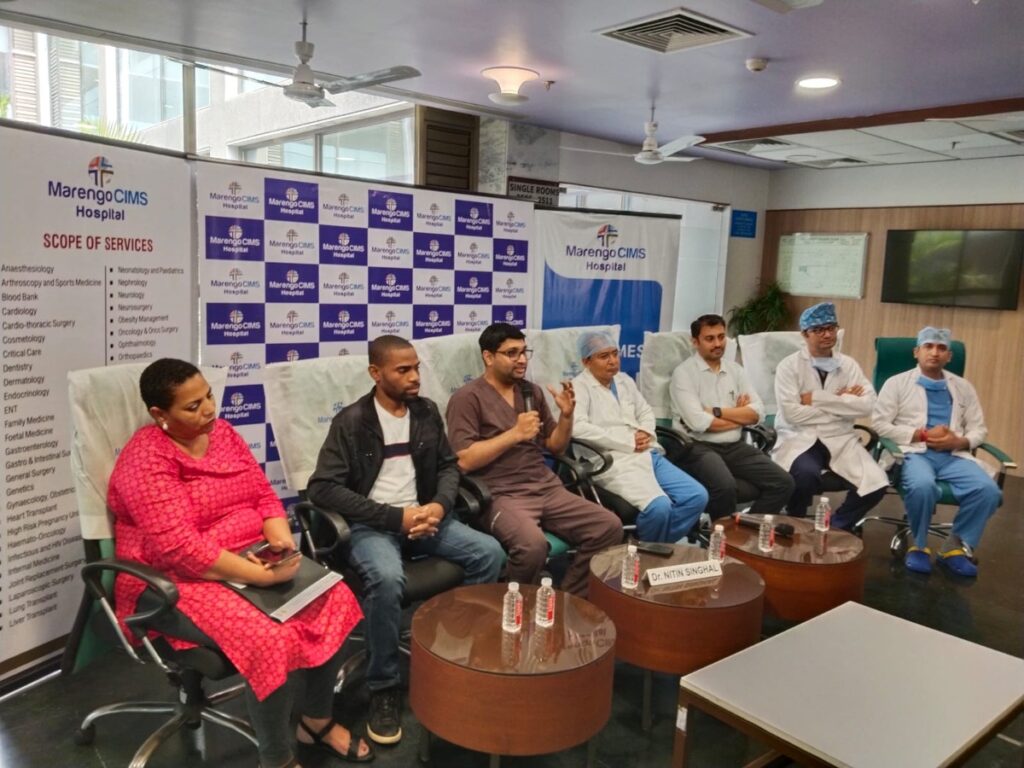Dr Nitin Singhal and Dr Swati Naik with competent team carried out 8 hours surgery successfully
- The patient had been suffering from the tumor since 2019 but no doctor was willing to operate
- This is a classic case of a patient with little time to live and clinical excellence is proven again
BILKULONLINE
By Rafat Quadri
Ahmedabad, Sept 11: When his life had shattered, his mother Roza was losing hope to keep his son Qadar Rahman,24 alive, the services of Marengo CIMS were recommended to them. They lives far away in Mozambique. They approached all the doctors possible in their country and took second opinions. But to their utter despair, he was ailing and was diagnosed of a tumor. But no doctor was willing to operate. He had little time to live.
When he came to Marengo CIMS he had uncontrolled hypertension, pulse rate, and severe headache. We had to carry out the rare surgery on him in a semi-emergency state. With ventilators at his reach the surgery was carefully conducted by Dr Nitin Singhal and Dr Swati Naik at Marengo CIMS hospital.
This rare type of tumor termed as pheochromocytoma, usually represented by severely elevated blood pressure, a sense of losing one’s life mimicking the symptoms of a cardiac arrest like shortage of breath, severe sweating, and rapid heartbeat, the oncology team led by Dr Deepak Desai and team at Marengo CIMS Hospital conducted yet another exemplary treatment surgery to save the life of the patient.
With the inordinate delay, the patient’s condition became so critical that it rendered the option of surgical intervention very difficult, along with the uncontrolled blood pressure and very high pulse because of which he was refused surgery at multiple places.
When he finally came to Marengo CIMS Hospital, he was re-evaluated to assess the complexity of his condition and the mass had more than doubled the size in a few months and had become even more challenging for the team of doctors. The tumor was stuck on the right kidney and liver and supplied by multiple vessels from the inferior vena cava(the main vessels that carry body blood into the heart) and head multiple neovascularity from renal vessels and lumbar vessels. Removing a major mass that was the size of a small football in such a young boy and saving his kidney without damaging the liver with the altered blood pressure which was very high (240/ 140 mmHg) was indeed a herculean task.
Usually, such patients are put on 7 to 10 days of alpha-blocker drugs to control the blood pressure, but in this case, due to compressive symptoms in the kidney and with the scan showing recent bleeding in the mass the case needed to be taken on an urgent basis. The patient had almost a mere 1 – 2 days to be saved from any fatality.
Dr Nitin Singhal, Clinical Director said “We are glad we could remove the mass enblock without major blood loss and could save the kidney and liver also and the patient is doing fine now. This mass is a giant pheochromocytoma by definition of the size of 18 x 15 x 13 cm and is probably one of the biggest adrenal pheochromocytomas that have been resected as per the best of our knowledge. We successfully achieved the task with wonderful teamwork with my Anesthetists Dr Deepak and Dr Mayank, Dr Swati Uro-surgeon and Dr Bhagyesh ( intensivist) and, Dr Vivek Patel ( endocrinologist).”
Dr Raajiv Singhal, Managing Director and Group CEO, Marengo Asia Hospitals comments that “Marengo CIMS Hospital remains steadfast in its dedication to delivering the highest standards of clinical excellence to save an increasing number of lives. Through this patient’s case, we are further emphasizing our dedication to MVT, or Medical Value Travel, which encompasses not only medical care but also the idea of creating accessible, top-quality healthcare and cost-effective treatment options through clinical corridors. Our ongoing efforts are committed to meeting the challenges of treating patients and igniting hope for those who travel across borders to seek medical assistance from our institution.”
Pheochromocytomas are rare, occurring in about 2 to 8 out of every one million people. Approximately 10% of patients are found to have pheochromocytomas in both adrenal glands, which is most commonly seen in younger patients with pheochromocytoma-related genetic syndromes.
